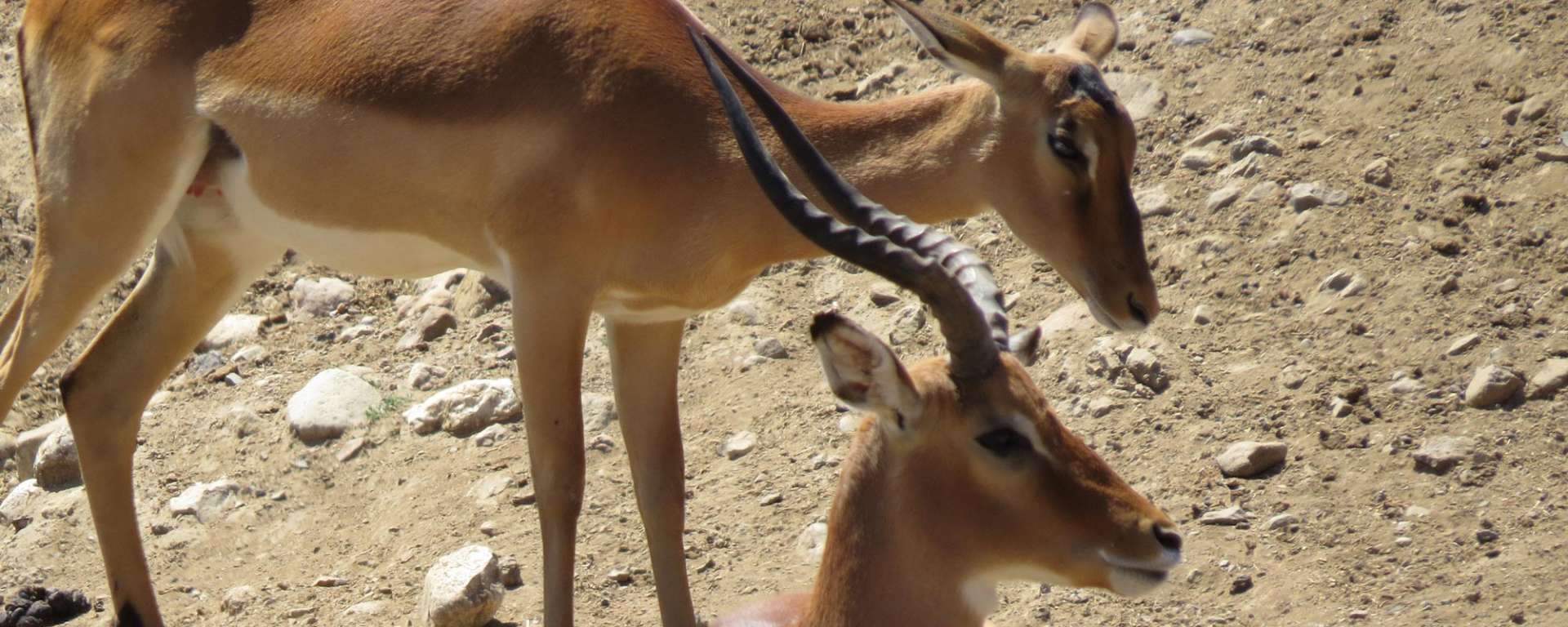Description
An elegant species of antelope, impala have a two-toned coat of tan underbelly and dark red back. Males have heavily ridged, wide-set, lyre or U-shaped horns that reach 18-37 in (45-92 cm). They have black stripes down the tail, forehead, thighs, and ear tips that might aid in recognition between individuals.
Classification
- Class
- Mammalia
- Order
- Cetartiodactyla
- Family
- Bovidae
- Genus
- Aepyceros
- Species
- A. melampus
- Conservation Status
- Least Concern
Key Facts
- Height
- 2.5-3 ft (~75-95 cm)
- Weight
- 88-176 lb (~40-80 kg)
The IUCN Red List describes Aepyceros melampus as a species of Least Concern with a population of nearly 2 million individuals.
Social Life
Impala are active at all times of the day, alternating between eating and resting, and drinking at least once a day. Three main organizations of impala are found: territorial males, bachelor herds and breeding herds. Territorial males attempt to control any female herds that wander into their territory and only the dominate male reproduces. Female and young impala generally stay within a fixed group that contains 30-200 individuals.
Habitat and Range
Impala favor fringe habitats where savanna meets woodland or where grassland meets savanna. They are found in eastern and southern Africa from South Africa north to Uganda and Kenya and from the east coast to as far west as eastern Angola. An isolated pocket exists in Namibia as well.
Diet
Unlike many herbivores, impala are both grazers and browsers which allows them to survive in areas where others cannot. They eat grasses, Acacia leaves, seedpods, blossoms, fruit, and dried leaves. Impala usually live near water but can go without drinking for extended periods of time.
Lifespan
In the wild impala typically live 13-15 years and 15-18 years in captivity.
Predators
Main Predators include lion, leopard, cheetah, painted dog, spotted hyena, crocodile, and python. Young impala can be carried off by martial eagles. Impala use various anti-predatory techniques, such as leaping up to 10 ft (3 m) in the air and over distances of up to 30 ft (9 m). They often leap up and/or out in many directions to confuse the predator.
Reproduction
Sexual maturity: Male: 1 year, Female: 1.5 year
Mating Season: March to May
Birth Season: September-December
Gestation: 6.5-7 months
No. of Young: 1-2
- Information
-
Description
An elegant species of antelope, impala have a two-toned coat of tan underbelly and dark red back. Males have heavily ridged, wide-set, lyre or U-shaped horns that reach 18-37 in (45-92 cm). They have black stripes down the tail, forehead, thighs, and ear tips that might aid in recognition between individuals.
Classification
- Class
- Mammalia
- Order
- Cetartiodactyla
- Family
- Bovidae
- Genus
- Aepyceros
- Species
- A. melampus
- Conservation Status
- Least Concern
Key Facts
- Height
- 2.5-3 ft (~75-95 cm)
- Weight
- 88-176 lb (~40-80 kg)
- Conservation
The IUCN Red List describes Aepyceros melampus as a species of Least Concern with a population of nearly 2 million individuals.
- Lifestyle
Social Life
Impala are active at all times of the day, alternating between eating and resting, and drinking at least once a day. Three main organizations of impala are found: territorial males, bachelor herds and breeding herds. Territorial males attempt to control any female herds that wander into their territory and only the dominate male reproduces. Female and young impala generally stay within a fixed group that contains 30-200 individuals.Habitat and Range
Impala favor fringe habitats where savanna meets woodland or where grassland meets savanna. They are found in eastern and southern Africa from South Africa north to Uganda and Kenya and from the east coast to as far west as eastern Angola. An isolated pocket exists in Namibia as well.Diet
Unlike many herbivores, impala are both grazers and browsers which allows them to survive in areas where others cannot. They eat grasses, Acacia leaves, seedpods, blossoms, fruit, and dried leaves. Impala usually live near water but can go without drinking for extended periods of time.Lifespan
In the wild impala typically live 13-15 years and 15-18 years in captivity.Predators
Main Predators include lion, leopard, cheetah, painted dog, spotted hyena, crocodile, and python. Young impala can be carried off by martial eagles. Impala use various anti-predatory techniques, such as leaping up to 10 ft (3 m) in the air and over distances of up to 30 ft (9 m). They often leap up and/or out in many directions to confuse the predator.Reproduction
Sexual maturity: Male: 1 year, Female: 1.5 year
Mating Season: March to May
Birth Season: September-December
Gestation: 6.5-7 months
No. of Young: 1-2

